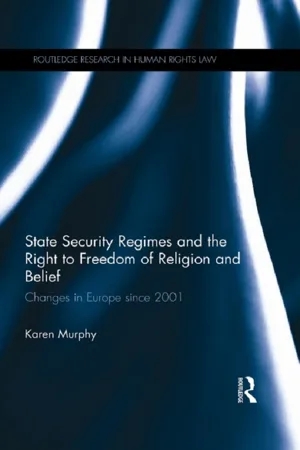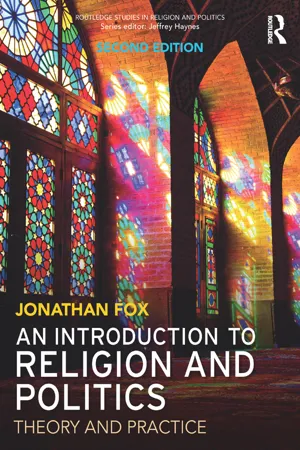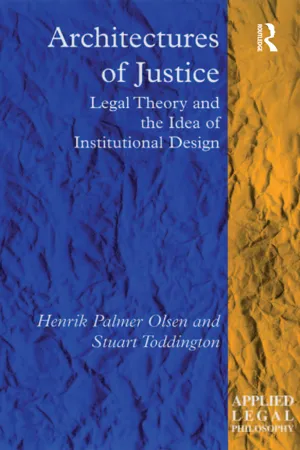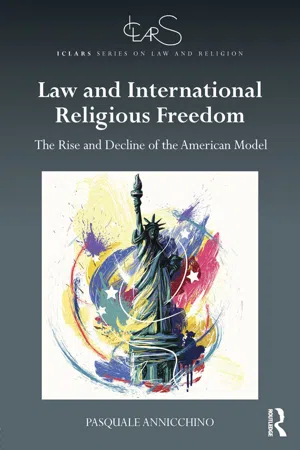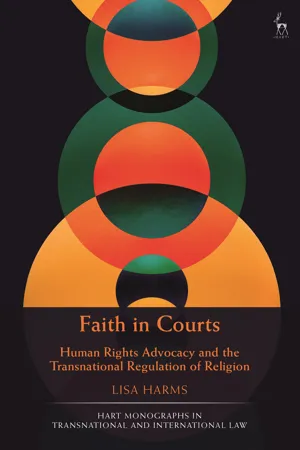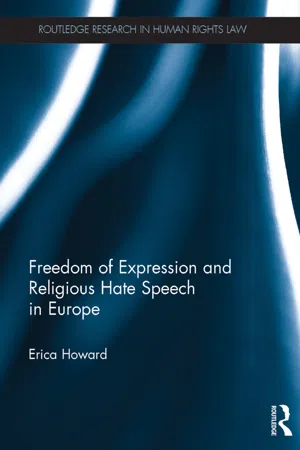Politics & International Relations
Freedom of Religion
Freedom of religion refers to the right of individuals to practice their chosen religion without interference from the government or other authorities. It encompasses the freedom to worship, express and manifest one's beliefs, and participate in religious activities. This fundamental human right is often enshrined in constitutions and international human rights instruments to protect individuals from discrimination and persecution based on their religious beliefs.
Written by Perlego with AI-assistance
Related key terms
Related key terms
1 of 4
Related key terms
1 of 3
7 Key excerpts on "Freedom of Religion"
- eBook - ePub
State Security Regimes and the Right to Freedom of Religion and Belief
Changes in Europe Since 2001
- Karen Murphy(Author)
- 2013(Publication Date)
- Routledge(Publisher)
The range of judgments emanating from the ECtHR, as well as the universal treaty organs, suggests: (a) a lack of consensus on what should be protected; and (b) a wide margin of appreciation for states. This is partly the result of the conception of religious freedom as having distinctive private–public parts and partly the result of the efforts of the human rights organs to allow scope for elements that they may not have originally foreseen. It also allows the state a safeguard in that it can prohibit acts that threaten the security of its citizenry. While this is practical in theory, in practice it places religious free- dom in a vulnerable position, putting it at risk of abuse and limitation under certain circumstances.According to the understanding of religious freedom which distinguishes between the private and public spheres, it would be impossible to infringe the right to Freedom of Religion or belief, unless using brainwashing tech- niques.133 However, there is an argument which places the inner forum of religious freedom in the line of possible discrimination and/or infringement and many commentators have pointed out that beliefs and actions are inter- twined and cannot be mutually exclusive. Religion, or religious belief, cannot always be contained within the private sphere. For some religions, religion is a way of life , and the members of the religious community are a people . Freeman has pointed out that every ‘great religion is not merely a matter of belief; it is a way of life; it is action [and one of the most] scathing rebukes in religion is reserved for hypocrites who believe but fail to act so’.134 Similarly Sullivan notes that ‘[m]any religious doctrines or beliefs dictate standards of social conduct and responsibility, and require believers to act accordingly. For those who follow such precepts of social responsibility, the distinction between religious and political activity may be artificial.’135 The tensions between civil law and religious dictates have been evident since biblical times.136 The ECtHR has noted that ‘[w]hile religious freedom is primarily a matter of individual conscience, it also implies, inter alia, free- dom to “manifest [one’s] religion”. Bearing witness in words and deeds is bound up with the existence of religious convictions.’137 - eBook - ePub
An Introduction to Religion and Politics
Theory and Practice
- Jonathan Fox(Author)
- 2018(Publication Date)
- Routledge(Publisher)
13 Religious freedom“Religious freedom” is a commonly used term in the study of religion and politics, but what does it mean? It is one of those terms that everyone “understands,” but upon closer inspection its meaning can be very different to different people. Even a superficial examination of the literature on religious freedom reveals that there is little agreement on the term’s meaning, or even whether religious freedom is the proper term to use. It is alternatively called religious rights (with variations such as religious civil or human rights), religious tolerance, religious liberty, religious equality, the free exercise of religion, and the right to a level religious playing field. Violations of religious freedom are called religious discrimination, religious persecution, religious intolerance, and religious repression. Each of these terms has its own meaning, and some of them have multiple potential meanings. In this chapter I explore all of these terms and their implications for practical policy.In addition to the debate over meaning, there is a debate over desirability. While from a classical liberal viewpoint religious freedom is an essential value, this value is disputed by both ends of the political spectrum, ranging from contentions that all religion is bad for society to contentions that a society must have uniform religious values to function properly.OFFICIAL RELIGIOUS FREEDOM
Religious freedom is present in multiple political documents, including international treaties and conventions, and most of the world’s constitutions, as well as the laws of many countries. However, while these legal documents often guarantee religious freedom, they rarely define it. They sometime list actions which would violate religious freedom but do not explain why some actions rather than others are included in these lists. - eBook - ePub
Architectures of Justice
Legal Theory and the Idea of Institutional Design
- Henrik Palmer Olsen, Stuart Toddington(Authors)
- 2016(Publication Date)
- Routledge(Publisher)
Individual faith and a frame of orientation to devotion among individuals becomes organized religion when belief is institutionalized. This is typically done through a designation of scripture that authoritatively constitutes the symbolic and ritualistic content and understanding of a faith. There are, of course, considerable variations within and between religions, but institutionalization is a necessary step if several persons are to share a common faith. It is characteristic of most religions that faith is to be made manifest and thus converted into physical action in various ways. This can be achieved though special and occasional ritual but might also extend to the everyday actions of the believer. These active observances might relate to food, clothing, social manners, personal hygiene, the upbringing of children, leisure, sexual activity, and so on. Activity thus imbued with religious significance affirms and enhances the importance of faith in the life of the individual by bringing together direct worship through prayer and a wide range of routine activity.The Right to Freedom of Religion and its Absorption into Other Human Rights
The political and social situation in which we find ourselves at the beginning of the twenty-first century has changed immeasurably since Freedom of Religion was introduced as a basic right; the rules governing this freedom remain, however, unchanged. It is, therefore, reasonable to suggest that we might re-examine the grounds of traditional acceptance of Freedom of Religion if only to revitalize our thinking and avoid a complacent stagnation of the jurisprudence relating to the area. We might begin by noting that the right to religious freedom gives rise to conflicts both between different religions, within religions that are ostensibly seen as being the same, and between religion in general and other considerations and interests. Let us examine, then, whether this conflict remains if we analyse religious freedom in terms of indirect protections provided by other fundamental rights, for example, the right to freedom of expression and the right to freedom of assembly and association.Freedom of Expression
The right to freedom of expression includes the right to receive information and ideas and impart them to others. It protects the spoken and the written word as well as other forms of communication such as images, films, symbols, signs, and gestures. An essential part of the exercise of religion concerns the receiving and imparting of information and ideas. The freedom to choose the information and ideas one wishes to impart and receive, and the freedom actually to so impart and receive them, are necessary conditions for religious action. Examples include access to, or purchase of, religious materials and literature (especially authoritative and sacred texts), the opportunity to listen to the spoken word in religious teaching or respond in discussion. The freedom of expression also covers the right not to receive information and ideas, thereby protecting the right not to receive religious information and ideas. Under the EHRC, Article 10, the freedom of expression also includes the freedom to hold opinions. Therefore, uncontentiously, we may say that the areas covered by the respective freedoms of religion in particular and freedom of expression in general, overlap.8 - eBook - ePub
Law and International Religious Freedom
The Rise and Decline of the American Model
- Pasquale Annicchino(Author)
- 2017(Publication Date)
- Routledge(Publisher)
17 indicating a preference for a neutral approach. It also describes the notion of religious freedom that is the theoretical linchpin of the text, derived from sources of international law: Article 18 of the Universal Declaration of Human Rights and Article 1 of the International Covenant on Civil and Political Rights. These sources yield the two fundamental sources of law:a) the freedom to have or not to have or adopt (which includes the right to change) a religion or belief of one’s choice, and b) the freedom to manifest one’s religion or belief, individually or in community with others, in public or private, through worship, observance, practice and teaching.18The Guidelines state that the terms “religion” and “conviction” must be understood in the broad sense, not limited to traditional religions only,19 and that any limitations to the right to manifest one’s own religion or conviction must be assessed according to a stringent criterion of proportionality.20The second part of the Guidelines defines the operational principles at the basis of EU action. It reiterates, first, the universal character of the right of religious freedom and its individual and collective nature. The third section of the second part, almost to signal deference to the states, highlights the priority role of the state entity in the protection of religious freedom. The presence of this section in the text of the Guidelines is probably due to the concerns of those states, which, in the Council on Foreign Affairs, feared the excessive activism of the EU in this regard at the expense of national prerogatives.21 - eBook - ePub
- Lorenzo Zucca(Author)
- 2017(Publication Date)
- Routledge(Publisher)
18 was founded on a concrete idea of religion. Otherwise, it would be difficult to understand the nature of this basic right in the legal context.This original approach to religious freedom presupposed the existence of God, in the Abrahamic sense of the term. One of its more influential proponents John Locke, affirms: “We are capable of knowing certainly that there is a God,”19 that “there is an eternal, most powerful and most knowing being; which whether anyone pleases to call God, it matters not.”20 According to this founding approach, religious freedom is the political freedom required to accomplish the duty of rending to God what human beings as creatures owe him according to justice or, in the words of James Madison, the father of religious freedom in the United States, “the duty which we owe our Creator and the manner of discharging it.”21As a result of an intense process of Western secularization over the last several centuries, belief in God is no longer socially axiomatic.22 This process has been accelerated so much by globalization and the resulting diversification that the right to religious freedom has changed shape in the international arena. The idea that the right to religious freedom should protect not only theistic religions but also all kinds of religious and nonreligious communities and creeds has been widely recognized worldwide by believers and nonbelievers and firmly adopted by international law.23 There is no question about this in contemporary democratic political debates.But this positive and realistic shift, aimed chiefly at avoiding discrimination in religious matters, can never justify the exclusion or marginalization of the idea of God as understood by deism, by the Abrahamic religions (Judaism, Christianity, and Islam), and by other forms of transcendent monotheism (for instance, Zoroastrianism, Sikhism, or Baha’i Faith); neither can it be used to reduce religion to a private matter. The idea of a transcendent God remains at the heart of the very idea of religion. Indeed, seeing transcendence as a nonconstitutive element of the legal concept of religion to extend the rights of religious freedom to all kinds of convictions and beliefs has nothing to do with eradicating transcendence (and especially God) from the idea of religion,24 - eBook - ePub
Faith in Courts
Human Rights Advocacy and the Transnational Regulation of Religion
- Lisa Harms(Author)
- 2022(Publication Date)
- Hart Publishing(Publisher)
Conclusion: Faith in Rights or Right Faith?T his book examined the contentious dynamics over the right to Freedom of Religion at the transnational level. By following a variety of religious and secular actors on their path to and through the world’s most influential international court – the European Court of Human Rights (ECtHR) – I shed light on the ‘demand-side’ of religious freedom struggles, which has remained under-researched in the court and state-centric scholarship on religious freedom. In so doing, I argued that legal mobilisation for religious freedom is fraught with ambivalences. On the one hand, human rights institutions have become important venues for religious minorities to voice their grievances, which has led the ECtHR to broaden the protection afforded to certain claims. On the other hand, legal mobilisation and litigation are not the exclusive affair of like-minded liberals, nor do all minorities have equal leverage when they address the Court. Political power dynamics and clashing ideologies resonate in various ways in the legal debates. Religious freedom, from this perspective, is not exclusively a legalistic concept or an institutional variable explaining national-level change, but a polyphonic space – or field – in which advocacy groups, movement actors, legal professionals and individual claimants vie for recognition and authority of interpretation.In the following, I will discuss the contributions this book has made to the two literatures in which this research was situated, namely the literature on the governance of religious freedom and the literature on human rights advocacy and legal mobilisation. I will end with an outlook on new developments in the field of religious freedom and on future research perspectives opened by this book. - Erica Howard(Author)
- 2017(Publication Date)
- Routledge(Publisher)
This would include views about religion or beliefs and whether to adopt these and whether to change religion or belief. And, again, both active and passive forms of freedom of expression are important here. In relation to both this and the previous argument, the term ‘marketplace of ideas’ has been used, meaning that there should be a market place for the exchange of competing ideas and beliefs, including religious beliefs. 20 In Handyside v the United Kingdom, the European Court of Human Rights mentioned that ‘freedom of expression constitutes . . . one of the basic conditions . . . for the development of every man’. 21 Fenwick and Phillipson mention as a separate argument or value ‘the argument from moral autonomy’, and explain that this centres around the liberal conviction that matters of moral choice must be left to the individual. And, again, this includes choice about whether to have a religion or belief and whether to change a religion or belief. The state offends against human dignity, or treats certain citizens with contempt, if the coercive power of the law is used to force the moral convictions of some upon others. 22 It is submitted that this can be seen as part of the argument or value on self-development and self-fulfilment. p.12 Barendt’s third argument for and value of freedom of expression has already been mentioned above, when the importance of the right to freedom of expression for a democratic society was pointed out: ‘freedom of expression plays a crucial role in the formation of public opinion on political questions’. 23 Barendt defines ‘political speech’ as ‘all speech relevant to the development of public opinion on the whole range of public issues which an intelligent citizen should think about’. 24 This suggests that the term ‘political expressions’ should be interpreted broadly and would include expressions on religion and beliefs that also contribute to the public debate
Index pages curate the most relevant extracts from our library of academic textbooks. They’ve been created using an in-house natural language model (NLM), each adding context and meaning to key research topics.
Explore more topic indexes
Explore more topic indexes
1 of 6
Explore more topic indexes
1 of 4
